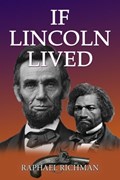This reality-based, alternate history was motivated by the continuing explicit and implicit racism in the United States, including the on-going, extra-judicial killings of non-violent, unarmed Blacks by poorly screened, poorly trained police and delusional, die-hard white supremacists.
Millions of us, including many of our leading lawmakers, not only deny the existence of systemic racism but seem blind to the cumulative harm of the continued injustice. We laid an immoral burden on the backs of Black Americans. We've been adding to it for generations. We are still suffering from the inability of millions of our fellow citizens to acknowledge the harm we've done and allowed to fester.
So I wondered, What Could Have Been If Lincoln Lived? Might he have been inspired by other people of goodwill to reimagine Reconstruction? The Reconstruction we created was undermined by craven politicians and white supremacists within just fifteen years of Lincoln's death. What could have been if people of color had been allowed to earn the respect due every human being; if they had been allowed a fair shot at opportunity and security? What could have been if these kidnapped African-Americans had been allowed to prosper in step with other minorities and whites ... to realize their dreams?
The story emerges from a single fantasy. Lincoln invites Frederick Douglass, a run-away slave who had made himself the most celebrated abolitionist of his time, to join him at Ford's Theater on the fateful night of April 14, 1865. Arriving in Washington a few days early, Douglass chances to learn about John Wilkes Booth pro-Confederate views. Douglass arrives at the theater alone and is spotted by Booth in the lobby. Booth is incensed at the idea of a Negro entering his white domain but has no idea that Douglass is Lincoln's guest. Later, when Booth enters Lincoln's box to kill the president, Douglass is able to intervene. He saves Lincoln's life, but both are wounded. In the hospital they bond and recognize things they have in common: Impoverished childhoods; learning to read and write from the bible; a love of Shakespeare; rising from poverty to become major national figures; having to struggle with the questions of freedom and equality for four million ex-slaves.
Lincoln invites Douglass to the White House to help him reimagine Reconstruction while they recuperate. They are joined by Elizabeth Keckley, another ex-slave but one who bought her freedom using the sewing skills she developed as a slave and her entrepreneurial spirit. Keckley is also a real historical figure. She established a booming business in Washington, became the fashion consultant to Mary Todd Lincoln, and was a frequent visitor to the White House. Keckley horns her way into the meeting Lincoln and Douglass have planned. She turns out to be a key contributor. When the two men are stuck and sulking after three days of heated debate, she is the one that comes up with a practical, creative solution on how to begin to integrate the four million newly freed but largely penniless Negroes.
The story has a number of ironic twists and a big one at the end. The very racism prevailing in the nation turns out to give birth to the solution. Lincoln seizes on Keckley's idea, seeing it as a kind of Trojan Horse, an inspired way to get Congress to pass new legislation that will ensure a path to equality and equity.
A path that would have been straighter and faster than the one we've been on for the past 155 years. That is, of course, If Lincoln Lived.

